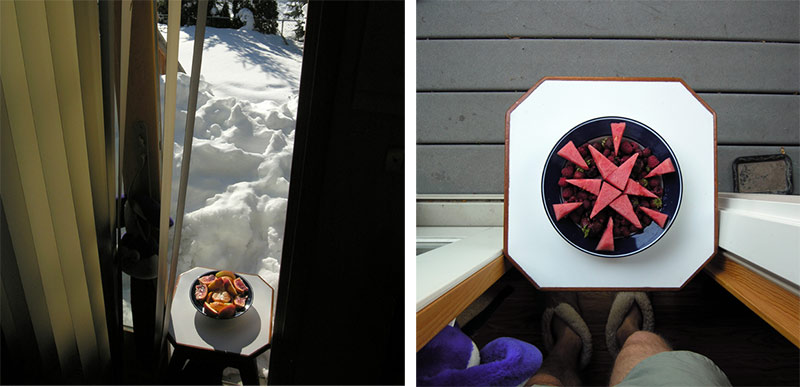
ARTIST STATEMENT
The genesis for this project stems from two desires. One is the wish to continue making art when I no longer have the luxury of time. Two is the wish to try against all the contradictory forces in our society to try to provide my kids some real food. Out of these seemingly unrelated urges came Fruit Plate.
I started cutting up fruit a number of years ago. Usually I just put it in a bowl as part of breakfast. As my daughter got older and my son came along, I began to arrange it to make it more appealing. I hoped visual attraction might lead to greater consumption – isn’t that how it’s suppose to work? The images are arranged starting with January 1 at the upper left and December 31 being at the lower right. In between they are top to bottom and left to right chronologically by month and day.
It’s a simple proposition: arrange fruit in a shallow blue-rimmed bowl and photograph it. Thus the basic design is given. There are repeating elements that anchor the entire scheme within which variation is provided by the fruit used. What then effects this second component? By doing this over a matter of years the activity inevitably engages ideas of time and because fruit is the marker, seasonality. No longer are we constrained by what we can grow here or have through cold-storage. With the proper allocation of personal resources you can have blueberries, strawberries as well as tropical fruits year-round. One can find certain clues to this fact in the photos. Our food choices are no longer affixed in a specific time or place that determine what we eat. Conversely, I do not give myself wholly over to enjoying “out-of-season” produce. As such the overall pattern of seasonality expresses itself in what types of fruit are present around what times.
Early on in my career as a curator I was taken by how a number of male photographers had adjusted their mode of working based on the introduction of a child into their lives. At the time, not having a child myself, I couldn’t entirely imagine the impact it would have. Some may jealously decry the limiting of male artistic genius through the societal changes in childrearing since the golden-age of modernism and the New Vision. Or you can look to the evolution of artists like Abelardo Morrell and others as an opportunity for new expressions that were previously considered outside the concerns of male artists. In either case I was forced to figure out a way to keep making images within the context of a daily routine that left little room for the mental time my earlier working style had afforded. Fruit Plate provided the perfect outlet: something that would be beautiful and engaged at the same time. So go out and enjoy some fruit in your life.
BIOGRAPHY
Roger Rowley, Prichard Art Gallery Director, has 25 years experience in not-for-profit gallery and museum work. He received his BFA from the University of Colorado and MFA from Visual Studies Workshop, Rochester, NY. He worked for the VSW Exhibitions Program during grad school and ran the VSW Traveling Exhibition Service. Later he became VSW Exhibitions Program Coordinator, teaching in the graduate program. In 2001 he joined the Museum of Art at Washington State University as Curator of Exhibitions/Collections Manager. While there he rediscovered two works in the collection made of natural rubber by Eva Hesse that were thought to have been destroyed. Becoming the Prichard’s director in October 2004, the gallery has since seen an average annual increase of at least 8% in attendance, donors and gifts. He has curated more than 60 exhibitions including the only presentation of all of William Kentridge’s works in the Northwest and a major solo exhibit and catalogue project by Bay area artist Kota Ezawa.